Getting Started with Time Blocking [Template Included]
Discover the advantages of time blocking and what the best practices are in this handy guide to time blocking. Find out why NotePlan is the perfect app for time blocking and use a template to set yourself up for success.
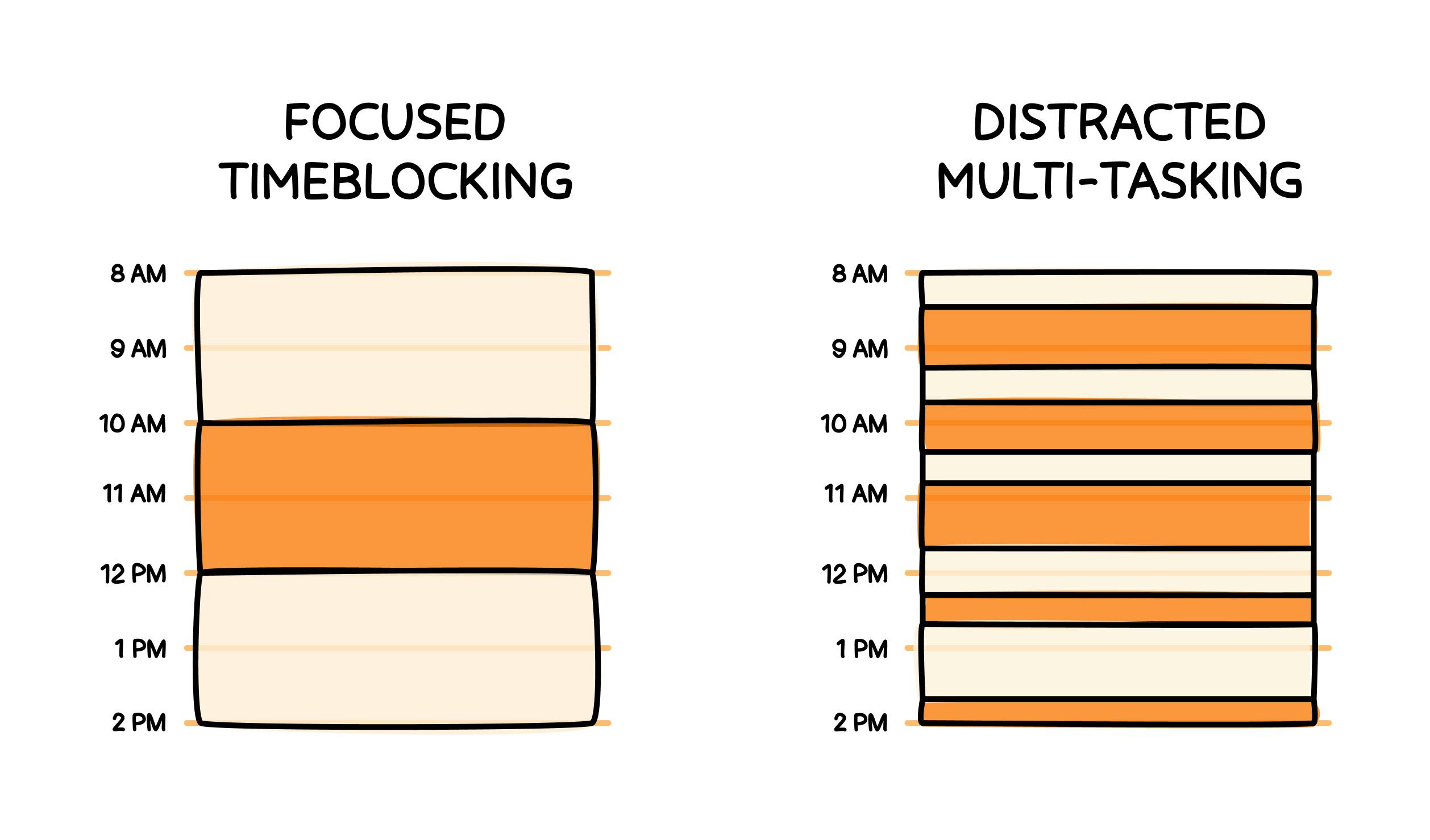
Planning & Productivity
What’s the most efficient way to plan your day and get things done? Is it a list of tasks sorted by importance, urgency, or energy? Is it a list of 3 big rocks you need to complete today? Or is it dividing your day into strict time units with clear tasks for every unit? If the latter appeals to you or you’re wondering whether it could work for you, it’s worth exploring the productivity technique called time blocking. It’s a method with a long history, famous practitioners, and many fans. But how does it work? And how do you get started? What are the pitfalls, and how do you set yourself up for success? Finally, can apps help you become a time-blocking superstar and be more productive?
Time to find out.
What is Time Blocking?
Time blocking or time chunking is a productivity method that divides a period of time, usually a single day, into predefined units of time and has you assign specific tasks to each unit. In practice, you divide a working day or even a week into several blocks of time, each with their own to-do item(s).
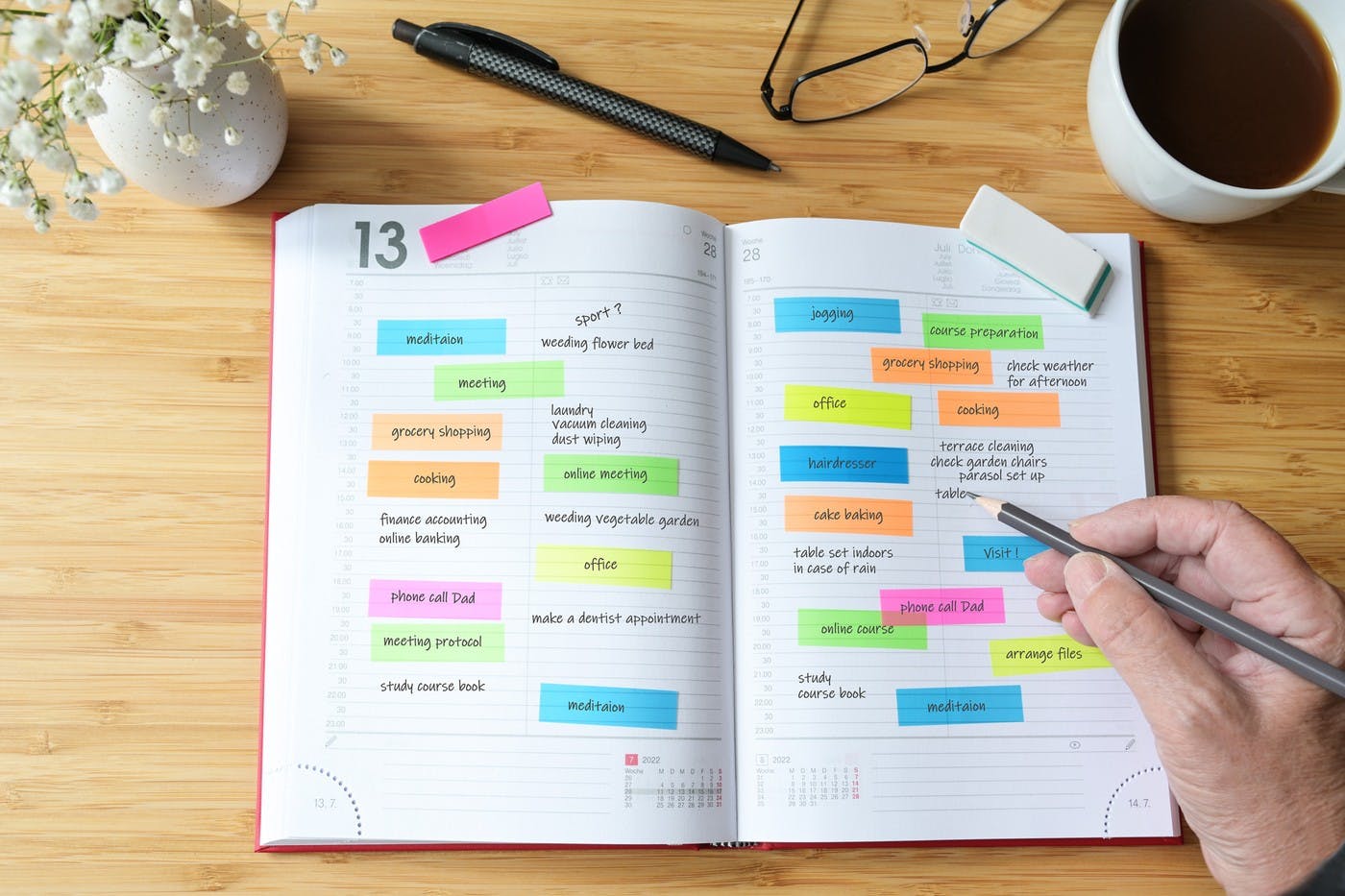
Some would say time blocking is a way of scheduling your work. And in some cases, time blocking has been referred to as “hyper-scheduling”. Some people have taken the method as far as micro scheduling and take into account every single activity in a day. But in general, time blocking refers to carving out big chunks of time on your daily calendar to make progress on tasks.
The Basics: Time-Blocking 101
The ingredients for time blocking are simple: a calendar or a schedule. A physical one works just as well as a digital one. You simply mark off times and add tasks for each time slot. Some people prefer using sticky notes with different colors for easy rearranging. Others use a pencil with an eraser.
Digital tools offer more flexibility than a paper page. Reshuffling blocks on a calendar or inside an app is fast and easy. It’s also more convenient to duplicate blocks, make blocks recurring, link items inside blocks to files or apps, etc.
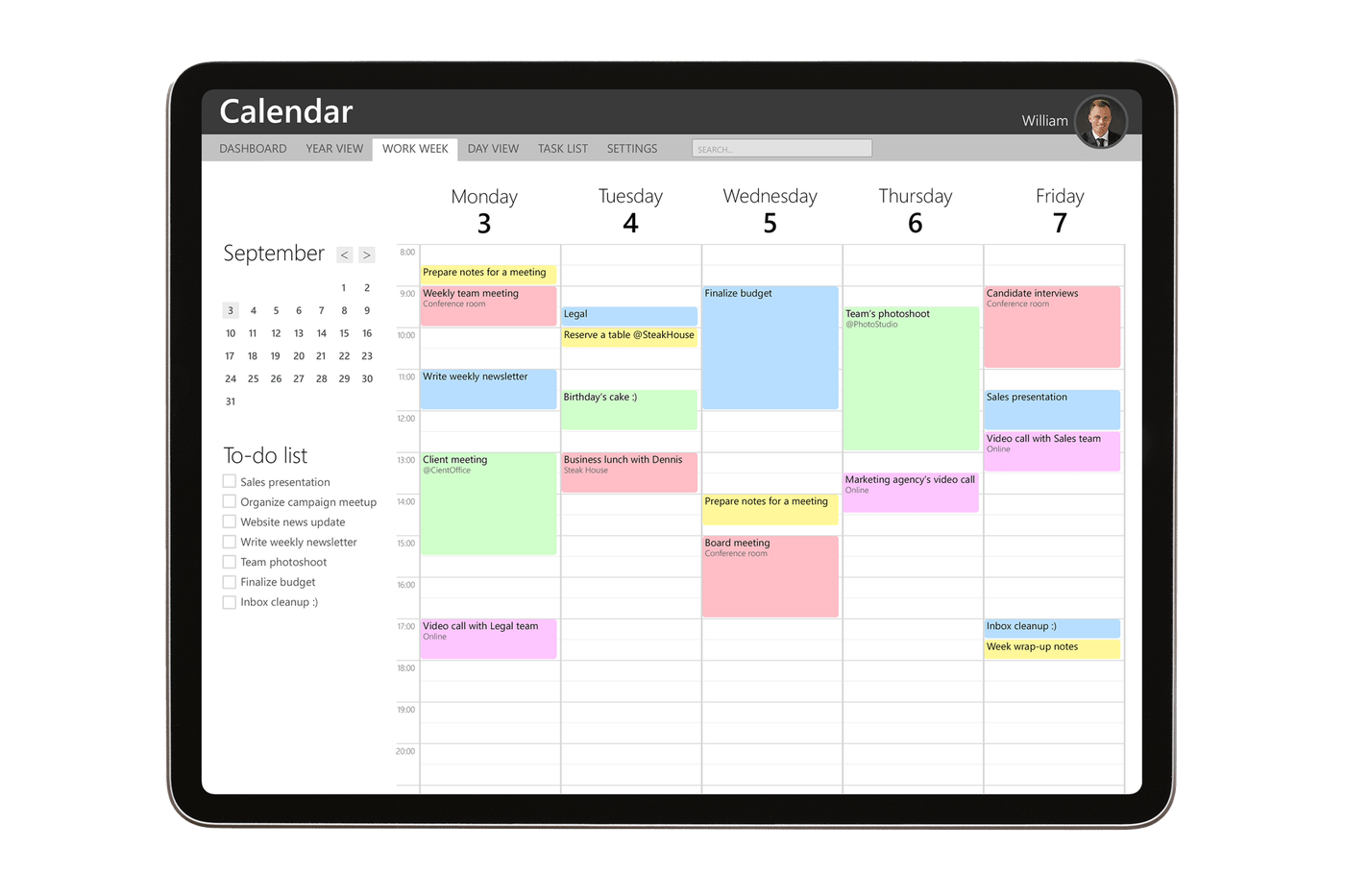
Time Blocking Advocates
Time blocking isn’t new: the practice goes back centuries. Benjamin Franklin was one of the early pioneers, and he stuck to a strict time blocking routine or schedule. Franklin divided his day into several large blocks for Work, Planning, Reading, and Sleeping. You’ll notice that he does not go into detail but simply marks off big blocks of time. Much has changed since the paper days of Benjamin Franklin, of course. Today, digital devices are everywhere, from our wrists to the phones in our pockets. And they all come with calendars, making time blocking easier than ever.
So it’s no surprise that several top performers and managers of large companies use the time blocking method today. Jack Dorsey, the former CEO of Twitter, is an advocate of the technique, saying:
On Monday […] I focus on management and running the company… Tuesday is focused on product. Wednesday is focused on marketing and communications and growth. Thursday is focused on developers and partnerships. Friday is focused on the company and the culture and recruiting. Saturday I take off, I hike. Sunday is reflection, feedback, strategy, and getting ready for the week.
— Jack Dorsey
Former Microsoft CEO Bill Gates and Tesla/SpaceX founder Elon Musk are fans of time blocking, too. But perhaps the biggest champion of time blocking today is author Cal Newport, who’s written extensively on the topic and his motivations behind the technique:
Sometimes people ask why I bother with such a detailed level of planning. My answer is simple: it generates a massive amount of productivity. A 40-hour time-blocked work week, I estimate, produces the same amount of output as a 60+ hour work week pursued without structure.
— Cal Newport
And Time Blocking Opponents
However, not everyone is a fan of time blocking. David Allen, the grandfather of Getting Things Done, is famously opposed to blocking off time for specific tasks using your calendar. He prefers to use a calendar only for “hard landscaping,” i.e., meetings, calls, and other engagements that have a fixed time.
In fact, Allen notes that planning with a calendar doesn’t work for two reasons. One, our daily work can get so busy it forces us to reevaluate our planning at a moment’s notice. He believes that constantly juggling tasks and time blocks makes the method a messy exercise. Secondly, putting something on a daily planning that is not critical to that specific day will take energy away from things that absolutely have to get done that day.
Lists embedded on a calendar don’t work. […] Trying to keep a list on the calendar, which must then be reentered on another day if items don’t get done, is demoralizing and a waste of time. […] The way I look at it, the calendar should be sacred territory. If you write something there, it must get done that day or not at all.
— David Allen – Getting Things Done
However, recently Allen may have warmed up to time blocking a bit more. In Making It All Work, he mentions:
Realizing, as you look through your calendar while considering what’s changed in the last few days, that you had now better block out two hours for yourself in the coming week so that you can finish drafting a document on time, is the kind of “aha!” moment that can help prevent the loss of control.
— David Allen – Making It All Work
What’s more, recently, Allen may have come around to time blocking, saying: “Time-blocking with yourself is simply recognizing that you have an inner committee that needs corralling, in the same way, for the same kind of outcome. Block away!”
With so many time blocking believers, you may wonder what the benefits and downsides are and whether you should use it, too.
Time Blocking vs Time Boxing vs Day Theming
Before we dive into the merits of time blocking, it’s good to clear up some confusion around different terms. Time blocking, time chunking, time boxing, day theming, task batching: there are many terms for many techniques. So let’s find out what’s what.

- Time blocking is dividing a day into several blocks of time to work on predefined tasks. Time chunking is a synonym. E.g. Work on Project Acme from 13:00 to 15:00 h.
- Time boxing restricts a task to a maximum amount of time and ties it to a clear goal or result. E.g. Write 500-word Project Acme proposal from 13:00-15:00 h.
- Task batching is a method where you group similar tasks in a single session. You may have a dedicated slot to answer emails, for example. Or a block focused on accounting work or filing receipts. Instead of doing it part by part across different days, you do it all in one go. The idea works perfectly with time blocking.
- Day theming is simply reserving certain days for specific activities. For example, Monday is marketing, Tuesday is Sales, Wednesday is Operations, etc. The above example from Jack Dorsey is a perfect illustration of day theming.
- Time tracking finally, is a way to audit where your time went. It’s important to note that this is a retrospective activity: it happens after the work is done. Time blocking on the other hand, happens ahead of the activity. If you time block, you may find you don’t need time tracking at all. Or you could still use time tracking tools (like Timing or RescueTime) to see if your planning matched up with reality.
Sometimes people use time blocking and time boxing as synonyms, although there is a subtle difference. You can have many time blocks of a particular activity, while a time box defines only a specific task with a finite result and a maximum time.
One method that’s often linked to time blocking is Francesco Cirillo’s Pomodoro Technique. The idea is to decide on a task, set a timer (usually 25 minutes), then take a short break and repeat the process for up to 3 times. The Pomodoro Method is generally considered a more ad-hoc method since it focuses on a single task, but doesn’t ask you to plan out all blocks of time in a day or week.
Why use Time Blocking?
Time blocking initially sounds scary to people who have never done it before. After all, planning every single hour of your day may sound restrictive and controlling. “Isn’t it stressful to plan everything and remove all flexibility?” Many people feel it takes away their freedom and that time blocking can easily go haywire when unexpected things cross your path.
There are certainly pros and cons to time blocking, so let’s look at both sides.
Advantages
It forces you to be realistic
We all love to plan a list of tasks on any given day or week, only to find out that we took on much more than we can handle. Most people tend to overestimate how much they can get done. Time blocking helps you overcome that. By planning out each day beforehand, you’ll need to think about how long you’ll work on a task. And you’re limited to the working hours available on any given day. Thinking of getting your inbox to zero during a small open time slot between meetings when your badge is at 43? That probably won’t work.
Time blocking helps you prioritize
As you plan your day, you’ll quickly notice what works and what doesn’t. Since you can only do so much during a day’s work, you’ll need to put important things first on the calendar. And allot the right amount of time to it. As you plan and prioritize each day, you will find out what requires more or less attention. And you’ll get to plan better the next day or the day after tomorrow to ensure that your top priority is done.
Using time blocks keeps you focused
Chronic procrastinators will know that nothing opens up the floodgates of distraction like an empty calendar, no plans, and no directions. Not having a clear list of actions simply lets you browse around, get distracted, or engage in other activities and be unproductive. But having a well-defined schedule of time blocks keeps you on-track. It creates a clear guide of what to work on and what to do next.
Time Blocking Minimizes Multitasking
Study after study has shown that multitasking is just not productive. When we bounce around from task to task, we lose valuable time. And energy. And even focus. There’s a steep cost associated with hopping around between tasks. You’re losing focus if you’re deep in development and suddenly take a call, open an email notification, or reply to a text. Time blocking helps you stay in the zone by having a clear start and end to a task. It lets you concentrate on your current time slot and block out other tasks that lead to multitasking.
Review your progress
If you do daily, weekly, monthly or other periodic review, time blocking also lets you see where your time actually went. A lot of people who time block have a slot in their weekly review to go over everything they accomplished by looking at their time blocks. By regularly performing a time blocking audit, you quickly understand where you’re actually spending your time instead of where you thought you were spending your time. What’s more: it lets you adjust accordingly when you time block tomorrow. Or next week.
You get more done
As Cal Newport noted earlier, time blocking is generally a more productive method. And while studies and data may vary, the consensus is that it delivers better results. Author Kevin Kruse interviewed “over 200 billionaires, Olympians, straight-A students and entrepreneurs” on productivity and notes:
In all my research, there is one consistent theme that keeps coming up. Ultra-productive people don’t work from a to-do list, but they do live and work from their calendar.
Downsides
With so many advocates for and advantages to time blocking, you may be wondering: what’s the catch? Shouldn’t everyone be time blocking to be more productive? There are definitely a few things to consider when it comes to implementing time blocking.
Your job may not be a fit for time blocking
The fact is that some jobs or roles are better suited to time blocking than others. A typical example of this is the maker vs manager paradigm.
Makers are people who create, design, or develop things (in a general sense). They often rely on large uninterrupted blocks of time to get into “the flow state”. That means a deep focus on a single task without calls, meetings, or notifications. They will often need multiple sessions to deliver a final result, such as a design, code, or content.
Managers, on the other hand, usually have meetings, calls, and one-on-ones. They could be short or long, end on time, or run on, finish early or even get cancelled. It’s hard to plan in advance.
It makes sense for makers to time block: it works well with the type of work they do. Managers can time block, too, but they will experience fewer benefits. And it’s much harder to block time accurately. Usually, they will end up reshuffling a lot of blocks.

There are other jobs that don’t work well with time blocking, too. People who work in fast-paced environments or who need to shift focus depending on what comes up will have difficulties using time blocking. For example, a P.A. who is heavily dependent on the calendar of her manager may find it hard to plan or time block ahead as she is heavily dependent on what comes up at a moment’s notice.
Time blocking may also be more challenging to implement if you’re in a sales role. Salespeople traditionally have to field a lot of calls from customers and frequently have to relinquish control over their calendar when that happens. They still may like to plan some blocks, but in reality they will often be at the mercy of other people’s schedules.
Some will argue that creative professions and time blocking are at odds, too. Creativity, they note, is not compatible with carving out blocks of time. Doing creative work is messy, unorganized, and doesn’t gel with the creative process. They argue that creativity is simply not a neat linear method that is swiftly divided into blocks.
And still. Several artists keep a solid routine that resembles time blocking or at least is akin to scheduling:
When I’m in writing mode for a novel, I get up at four a.m. and work for five to six hours. In the afternoon, I run for ten kilometers or swim for fifteen hundred meters (or do both), then I read a bit and listen to some music. I go to bed at nine p.m. I keep to this routine every day without variation. The repetition itself becomes the important thing; it’s a form of mesmerism. I mesmerize myself to reach a deeper state of mind.
— Haruki Murakami
Your personality type doesn’t work with time blocking
Time blocking may seem to be an activity that’s a match for people who are very organized and punctual. After all, the tendency to plan and structure a day may be a reflection of someone who naturally works this way. People who like to work more freeform may experience rigid rules as uncomfortable and unfamiliar.
Yet here, too, research and data seems to suggest that organizational skills, including time management and time blocking, can be a learned skill. Even for those of us who dislike strict rules.
The best way to find out whether you or your role works with time blocking is simply to try it for a couple of weeks.
Best Practices for Time Blocking
There are many different ways to approach time blocking and the key is to find a system that works for you. You can play with large blocks of different hours or just keep blocks limited to strict divisions of, for example, one hour. There’s no one size fits all. There are, however, a few best practices to keep in mind to increase your chances of sticking with a system and making it successful.
Block your time the evening before
It’s a widespread productivity technique to plan ahead, especially when it comes to time blocking. Time blocking your day the evening before makes it easy to start the next day. For starters, you’ll have a good idea of your priorities in the evening, after a day of progress. Secondly, you won’t start the next day wondering what to do first and falling into the procrastination trap. Since you’ve planned ahead, all you need to do is… begin.
Break up tasks into smaller blocks
Large projects may be daunting to start. “Write Business Plan” is something that could take a few hours over many days. If you break it down into smaller, bite-sized time blocks, it’s easier to get started. You may want to create a one-hour block “Business Plan: Research Market”, and another one “Business Plan: Product-Market Fit” and so on.
Use set time blocks to create rhythm
Many people who time block days and weeks stick to regular blocks. For example, they have a block between 8 am and 11 am for “deep work” each day. While the actual tasks may vary from day to day, the working hours do not. Structuring each day with fixed time blocks also creates a rhythm: your mind quickly adapts and shifts into working mode between those hours.
Know your productivity type
Maybe you like to get up early in the morning. Or perhaps you’re a night owl who likes to sleep in and get started late in the afternoon or evening. No matter which type you are, it’s crucial to time block for the way you work best. If you’re an early riser, plan large uninterrupted blocks in the morning and schedule low-energy blocks (with batch tasks such as paperwork, calls, or email processing) later in the day.
Plan your breaks
It’s crucial to time block your breaks, too. From taking a short breather or a walk after lunch to a slot for winding down at the end of the day. If you don’t, your work blocks will spill over and have a tendency to run on. And invade your personal time and space. You need breaks to work more efficiently and stay focussed.
Add buffer blocks
Adding buffer blocks or at least adding buffer time to your blocks is a good practice, too. A plan is just a plan: things can come up and force you to switch gears. That’s OK. A meeting might run long, or you might finish early. Giving your blocks a bit of padding is like providing breathing room. It means you don’t have to stress out if things go wrong.
A Time Blocking Example
A time blocking example like the one below will give you an idea of how you can get started.
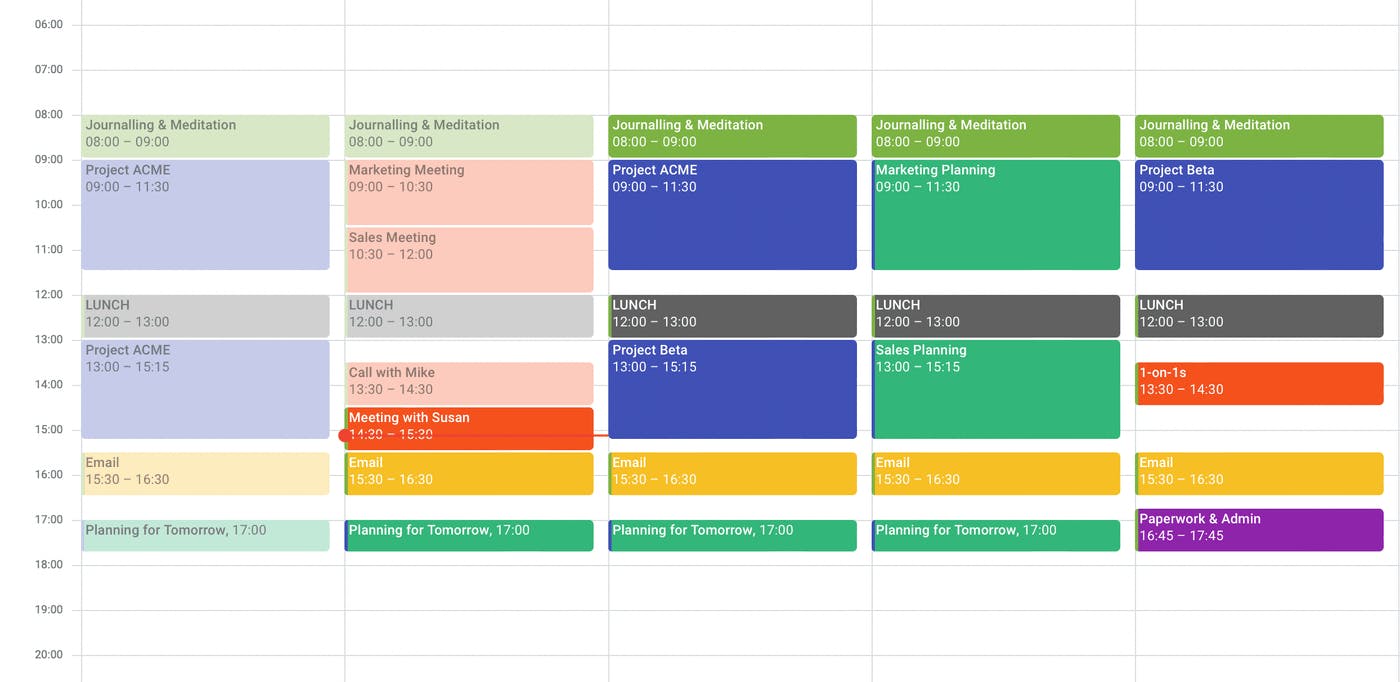
You’ll notice a couple of things:
- There are open spaces between many blocks to allow for buffers;
- This person is an early riser who plans important work in the am;
- The example uses day theming, too. Tuesdays have meetings and calls, Thursdays have planning;
- Different categories are color-coded for easy reference;
- Non-work activities like lunch and mediation are on the planning, too;
- Each day has “email” at the end of the day at a fixed time
NotePlan & Time Blocking
All you really need to start time blocking is a calendar. Even a paper journal could do. But using an app has several advantages. Especially when you use NotePlan.
NotePlan was built for time blocking and gives you flexible options. For starters, NotePlan comes with daily notes that automatically show you what’s on your calendar app. If you love to time block in iCloud/Google calendar, you’ll see your time blocks alongside your daily note. But that’s just the start.
Inside your daily note, you can instantly create time blocks by typing a timecode like: 9-11 am or 15:00-16:00. It doesn’t matter where you add it, NotePlan will automatically put the task on your calendar inside NotePlan. Without adding it as an event inside your regular calendar. That way, you keep dedicated appointments separate from what’s on your planning in NotePlan. By time blocking tasks in NotePlan, you can easily plan your day and add tasks around your existing appointments.
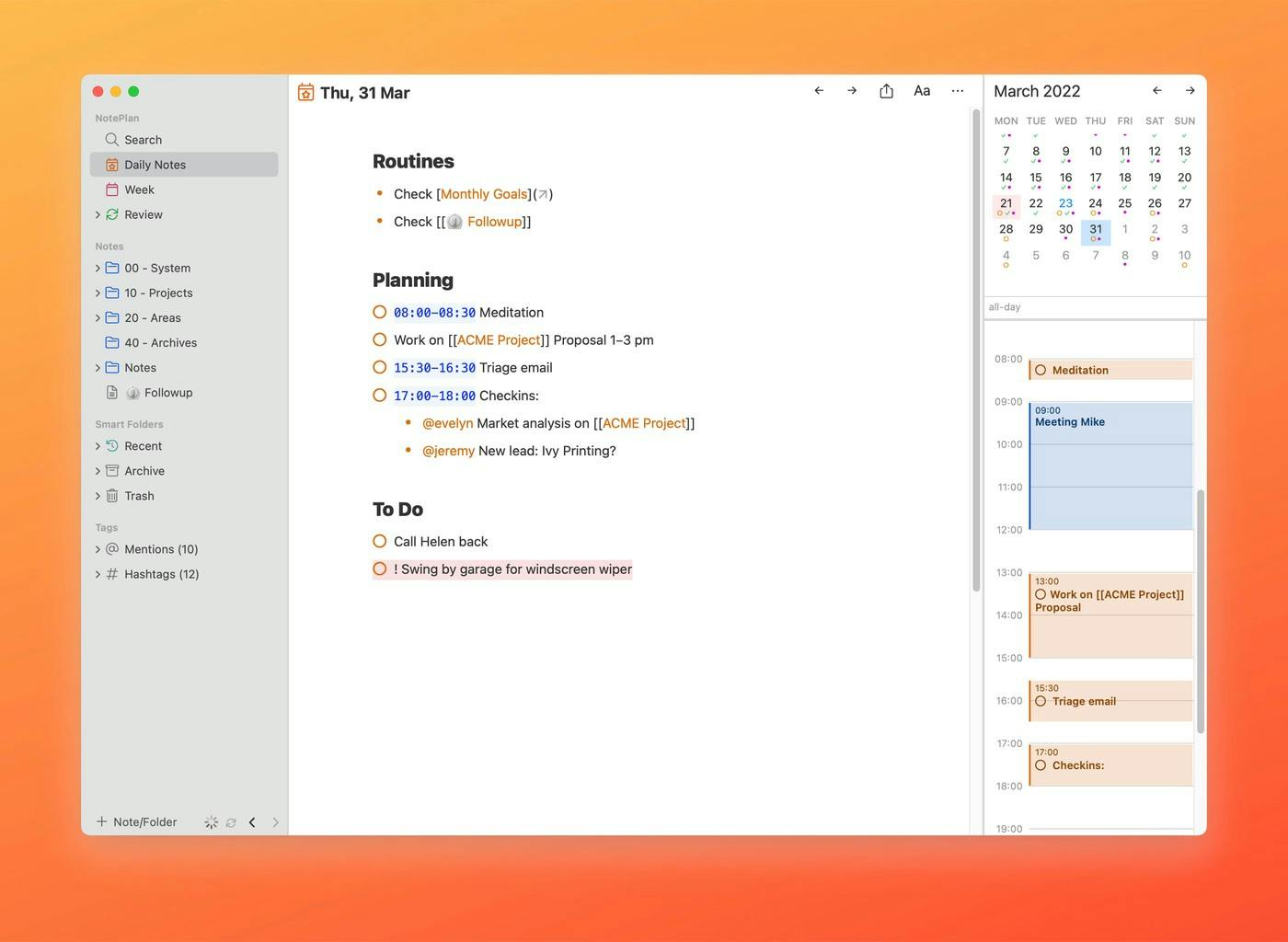
Suppose you prefer to add your calendar events inside your daily note. In that case, you can use the Event Helpers plugin. What’s more, you can even turn your NotePlan time blocks into full calendar events. So you can work with time blocks in NotePlan in any direction: from your calendar into NotePlan and the other way around.
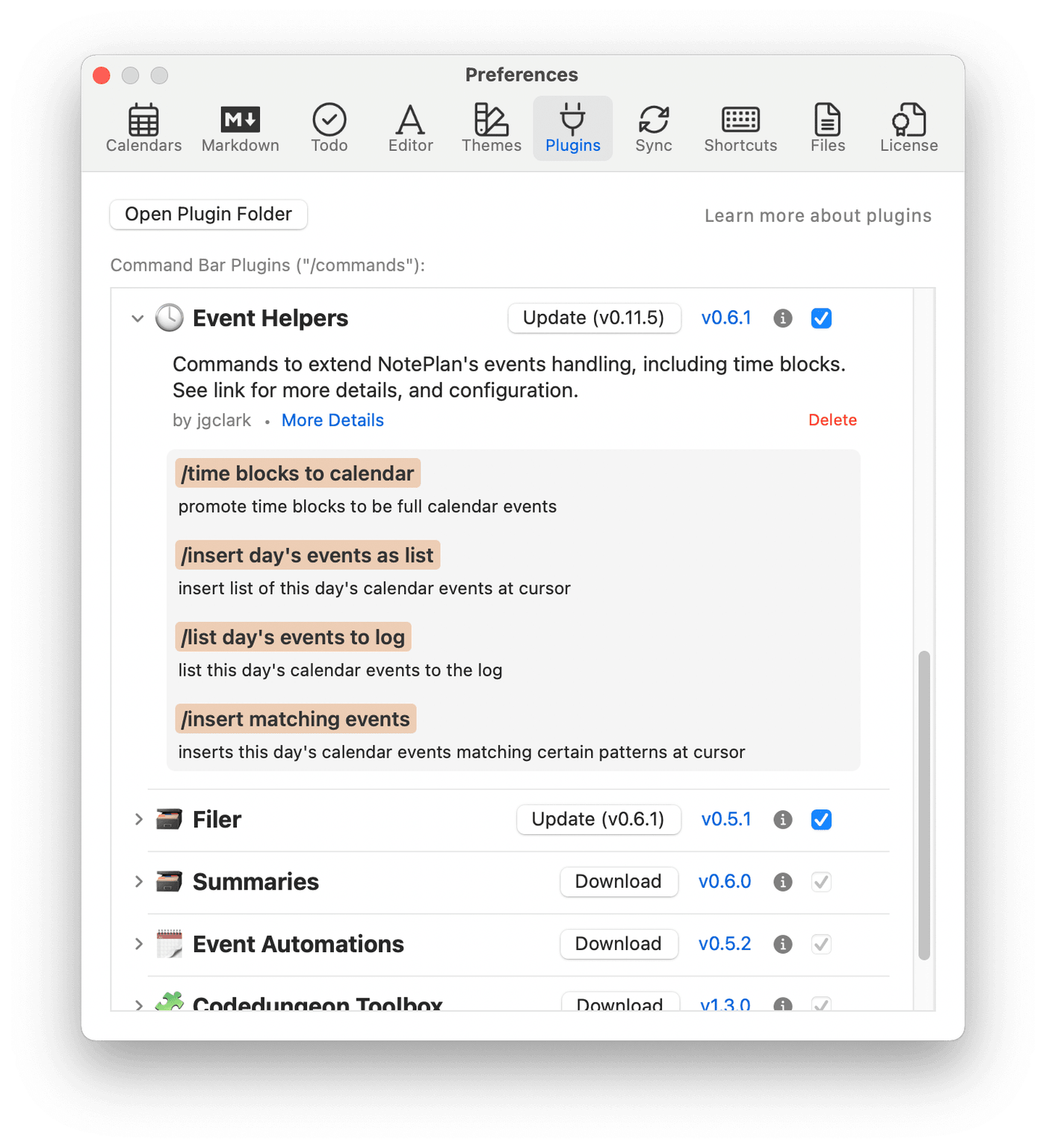
There’s even an efficient way to work with regular time blocks. By adding a time code to a task and making the task repeating, you can add a daily time block to your calendar.
For example, add * 3-4pm Check mails to your daily note, then repeat it by clicking on the arrow button which appears on the left. Or add - 3-4pm Check mails >today to any regular note (non-calendar) and it will appear every day in your timeline on the right.
Next, if you use templates in NotePlan, you’ll be time blocking on auto pilot. If you combine Templates with time blocks inside and assign a shortcut, you can set up your daily planning faster than ever. Just create a template note for your day, bring up the command bar and insert your daily note!
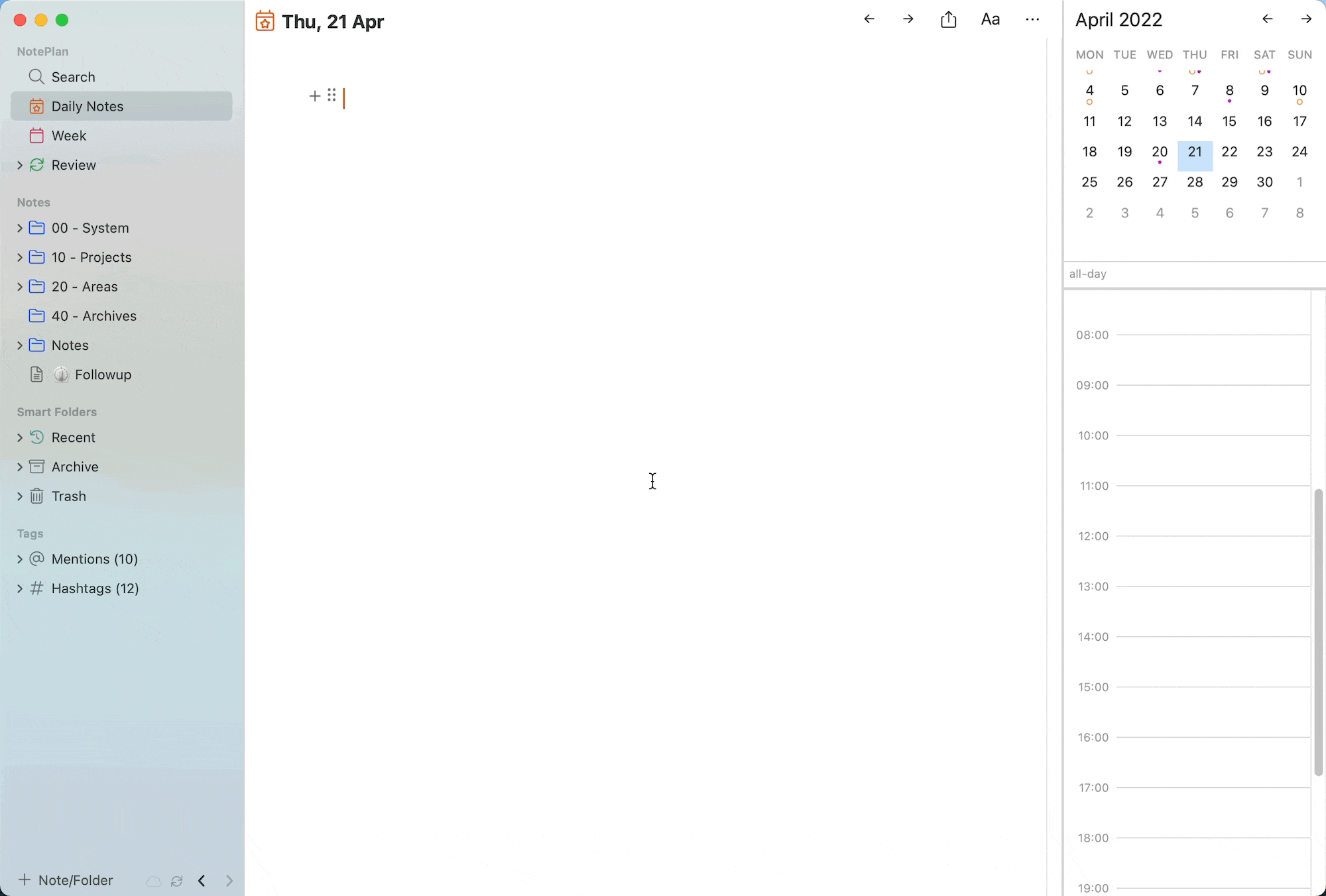
No matter how you want to work with time blocks, from displaying them from your calendar to just creating them inside NotePlan or to moving them from your daily note to your calendar: NotePlan allows you to do it.
A Time Blocking Template
To make sure your next time blocking experiment is a success, we’ve created a NotePlan Template. Add it to NotePlan by opening the link, then copy the contents into a new note. You can use the “Templates” plugin (see Preferences -> Plugins) to insert it with a command or simply copy/paste it into a new daily note every day (version v3.5 will have more templating features and this template will be automatically included).
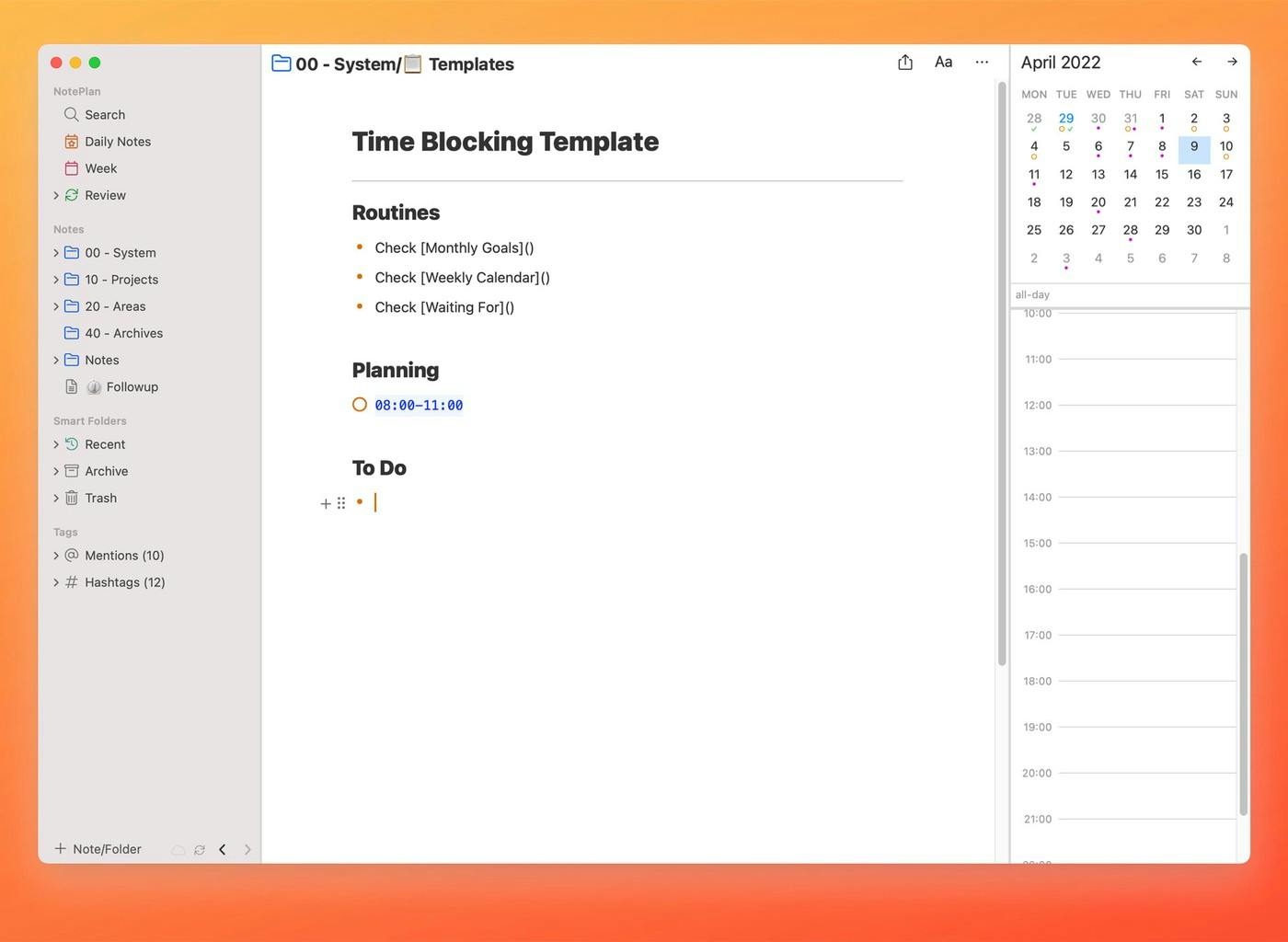
Here’s how the template works:
- The template has a few sections: Routines, Planning, and To Do. Feel free to create more!
- Under Routines, you can add links to other notes such as “Monthly Goals” or add a few things you may reference every day, like a “Waiting For” list (or click on the suggested links to create the notes).
- Planning allows you to plan your day with time blocks. If you have fixed blocks, just add them to the template note and they’ll be inserted directly.
- To Do finally, is a place to put things that come up during the day. Usually, these will fall outside your planning. That’s why they are marked with bullets and not as to-do items. It’s good practice to go through these items in the evening and flesh out what the next action is for each one. Then promote the bullets to tasks (Cmd+L) and drag them to any day you like.
Time to Get Productive
Time blocking can be one of the most powerful ways to become more productive and achieve more in a single day. To set yourself up for success, keep the best practices in mind, use a flexible app to make time blocking easy, and just get started. If you want to explore how NotePlan makes it easy to time block, work with tasks and calendars, and create a network of notes, then give the app a spin today!
Can one app really replace your entire productivity stack?
NotePlan did. Try NotePlan free for 7 days to learn how